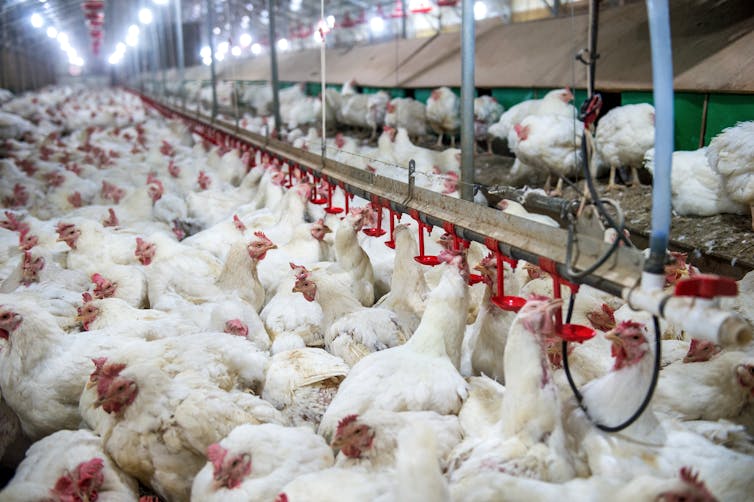Poultry on the rise
Virtually all nations studied (30 of 35) expert a gradual enhance in annual per capita poultry consumption between 2000 and 2019. It doubled in 13 nations, with better than 20kg eaten yearly in Peru, Russia and Malaysia.
Together with the poultry commerce’s long-term consider creating low value and helpful meals, many western customers in the mean time are altering beef with poultry. One potential trigger is because of its smaller environmental footprint: chickens require a lot much less land and generate so much lower emissions than cattle.
Nonetheless, this comes at a price. It exposes the world, along with Australia, to new virus outbreaks such as a result of the hen flu, and ends within the overuse of antibiotics in livestock. This would possibly end in antimicrobial resistance rising, and the dearth of antibiotics to take care of human bacterial infections.

Industrial farming practices might make animals further inclined to sickness. Shutterstock
Industrial farming practices have added further pressures, with animals raised in confined areas the place they’re merely uncovered to pathogens, viruses and stress, making them further inclined to sickness.
Now now we have seen comparable impacts in China, the world’s largest producer and shopper of pork. Our analysis revealed predominant dietary fluctuations, equal to when pork consumption dropped significantly in 2007 after prices elevated by over 50%, following outbreaks of swine influenza and SARS outbreaks in folks on the time.
Which nations have reached peak meat?
Whereas meat consumption elevated all around the world on frequent, taking a greater take a look at specific individual nations reveals a further refined story.
Of the 35 nations we studied, 26 had a clear correlation between GDP progress and meat consumption ranges. For the remaining 9, there was no such a correlation, whereas six appeared to have reached a meat consumption peak: New Zealand, Canada, Switzerland, Paraguay, Nigeria and Ethiopia.
The reasons for this span both facet of the monetary wealth spectrum.
The three western nations might need decreased meat consumption attributable to acutely conscious preferences for plant-based meals, as a result of the nicely being and environmental benefits develop to be further well-known. Most notably, people in New Zealand decreased their frequent consumption from 86.7kg in 2000 to 75.2kg in 2019.
For the remaining three nations, reaching the peak more than likely wasn’t voluntary, nevertheless related to monetary downturn, local weather calamities and virus outbreaks. In Paraguay, as an example, an outbreak of foot and mouth sickness in 2011 resulted in cattle slaughter.
Australia continues to be one in all many world’s excessive meat-eating nations, with an annual consumption of 89.6kg per capita in 2019, up from 88.2kg per capita in 2000. Most of this was poultry.
Outside livestock are terribly weak to extreme local weather events, equal to droughts, heat waves and floods. That’s one trigger the share of beef in Australia’s meat exports decreased by 15%, ensuing from local weather extremes and drought all through 2019. Beef consumption in Australia nonetheless stays extreme in relative phrases.
